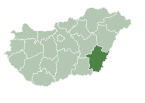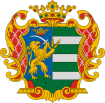Békésszentandrás
Békésszentandrás | |
|---|---|
Large village | |
|
UTC+2 (CEST) | |
| Postal code | 5561 |
| Area code | (+36) 66 |
Békésszentandrás is a
.Geography
Békésszentandrás, the western gate of Békés county, lies along the left bank of the Hármas-Körös River. The territory of the village is divided by the M44 road. The village is situated 150 km from Budapest, the capital city, and 50 km away from the town of Békéscsaba. It covers an area of 77.45 km2 and has a population of 3608 people (2015).[1]
The area has many prehistoric tumuli, known locally as kunhalom ('Cumanian Barrow'). The largest is Gödény-halom with a height of over 12 metres.[2]
History
After the Hungarian conquest nearly seventy settlements were founded in the region of the
In 1596
In the early 1700s a magistrate, György Száraz received the territory for 32,000
The 19th century population of Szentandrás increased steadily. In 1827 3,740, in 1852 4,941, in 1890 6,362 inhabitants lived here. The village took part in the 1848-49 Independence War and several people became a victim. The most important event of that century was the river regulation so life became safer. The village was named Békésszentandrás at the end of the 1800s. Both World Wars had many casualties in the village, a Heroes' Statue reminds them which was inaugurated by József Archduke in 1927. One of the important results of the inter-war period is the introduction of carpet making which made Békésszentandrás world-famous. The others are the modernisation of the local administration and the secession of
In the post-war period
In 1970 Békésszentandrás got the so-called incorporated town title.
Since 1990 the village has been supplied with public utilities like the sewerage-, gas pipeline-, IT network and drainage ditch system. Most of the roads are fitted with solid surface. After the realisation of the future plans there's a realistic chance to establish a small town from the village.
Famous people
- Ildikó Komlósi, Hungarian mezzo-soprano[citation needed]
- László Hadady (born 1956), oboist
- Bene Martin dancer, boxos, junior team footballer
References
- ^ a b Gazetteer of Hungary, 1st January 2015. Hungarian Central Statistical Office. 03/09/2015
- ^ "Békésszentandrás (The County of Békés)". National and historical symbols of Hungary. Archived from the original on 15 August 2017. Retrieved 1 March 2017.
External links
![]() Media related to Békésszentandrás at Wikimedia Commons
Media related to Békésszentandrás at Wikimedia Commons
- Official website in Hungarian


